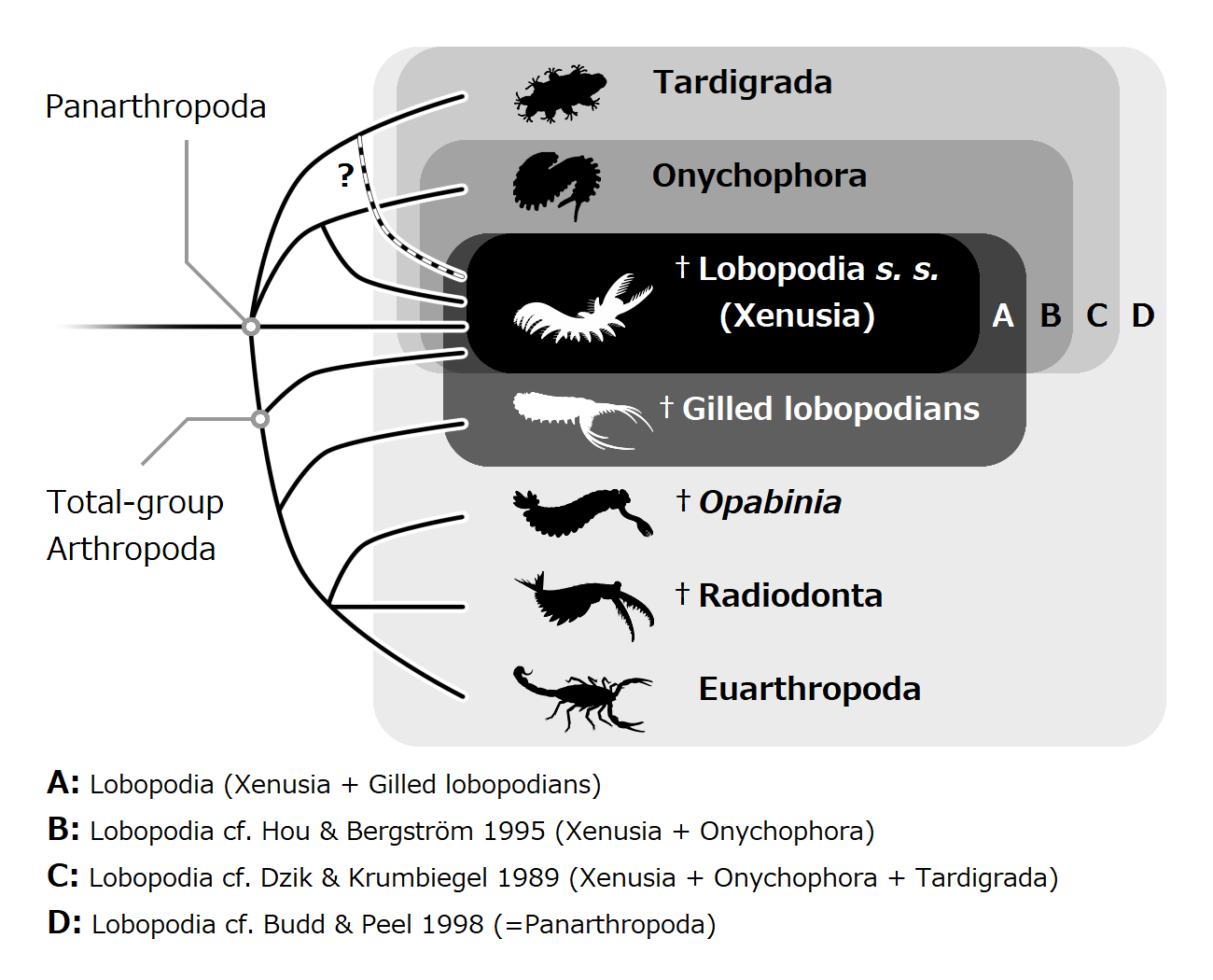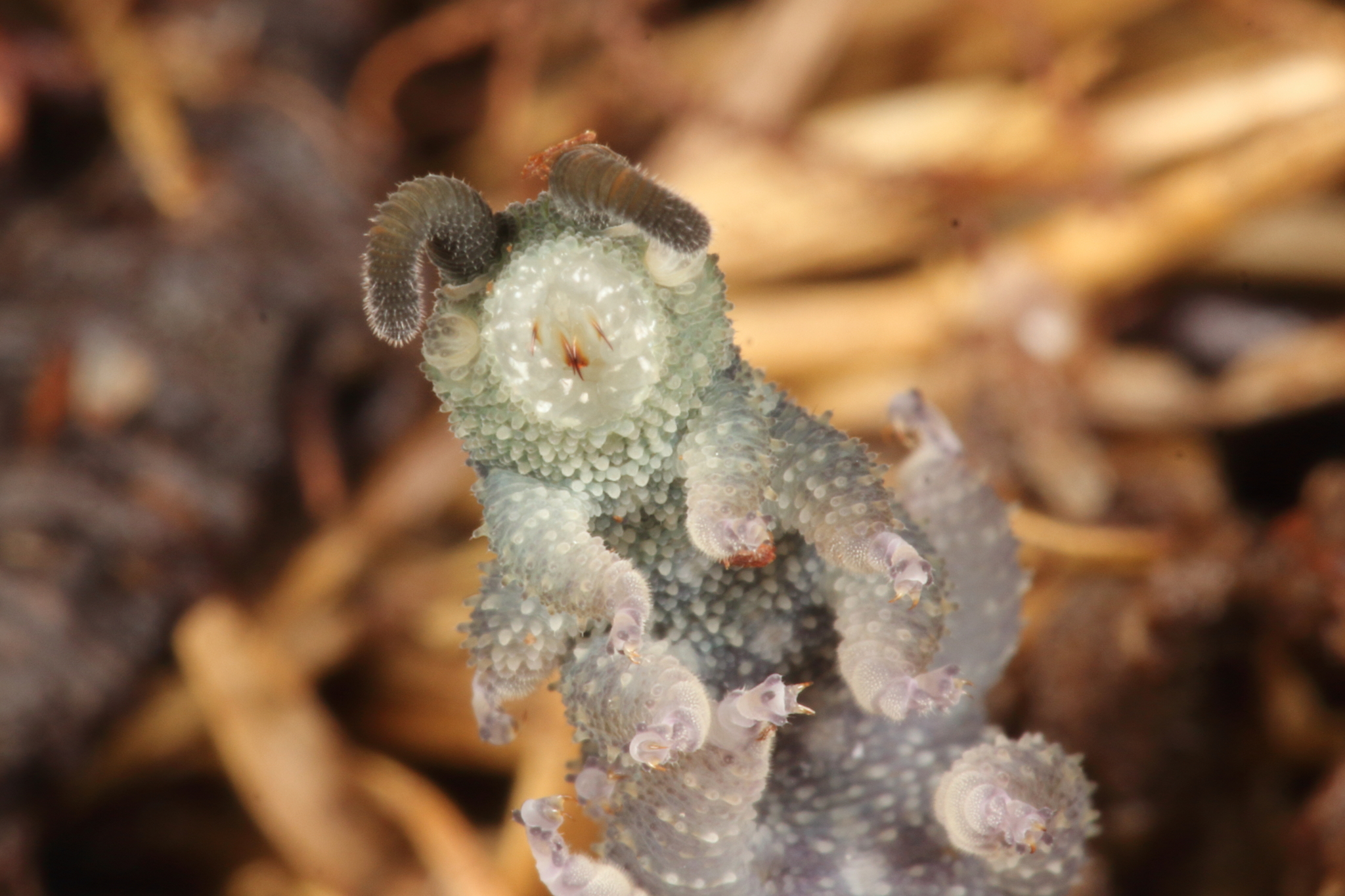|
Lobopodian
Lobopodians are members of the informal group Lobopodia (), or the formally erected phylum Lobopoda Cavalier-Smith (1998). They are panarthropods with stubby legs called lobopods, a term which may also be used as a common name of this group as well. While the definition of lobopodians may differ between literatures, it usually refers to a group of soft-bodied, marine worm-like fossil panarthropods such as ''Aysheaia'' and ''Hallucigenia''. However, other genera like ''Kerygmachela'' and ''Pambdelurion'' (which have features similar to other groups) are often referred to as “gilled lobopodians”. The oldest near-complete fossil lobopodians date to the Lower Cambrian; some are also known from Ordovician, Silurian and Carboniferous Lagerstätten. Some bear toughened claws, plates or spines, which are commonly preserved as small carbonaceous fossil, carbonaceous or Small Shelly Fossils, mineralized microfossils in Cambrian strata. The grouping is considered to be paraphyletic, as ... [...More Info...] [...Related Items...] OR: [Wikipedia] [Google] [Baidu] |
Diania
''Diania'' is an extinct genus of lobopodian Panarthropoda, panarthropod found in the Lower Cambrian Maotianshan shale of China, represented by a single species - ''D. cactiformis''. Known during its investigation by the nickname "walking cactus", this organism belongs to a group known as the armoured lobopodians, and has a simple worm-like body with robust, spiny legs. Initially, the legs were thought to have a jointed exoskeleton and ''Diania'' was suggested to be evolutionarily close to early Arthropod, arthropods, but many later studies have rejected this interpretation. Discovery Fossils of ''Diania'' were discovered independently by Jianni Liu from the Northwest University (China) in Xi’an, Qiang Ou from the China University of Geosciences (Beijing), China University of Geosciences in Beijing and Michael Steiner of the Free University Berlin. The fossils come from the famous Chengjiang deposit – or Maotianshan shale – of south-west China and are about 520 million years ... [...More Info...] [...Related Items...] OR: [Wikipedia] [Google] [Baidu] |
Luolishania
''Luolishania'' is an extinct genus of lobopodian panarthropod and known from the Lower Cambrian Chiungchussu Formation (Maotianshan Shales) of the Chengjiang County, Yunnan Province, China. A monotypic genus, it contains one species ''Luolishania longicruris''. It was discovered and described by Hou Xian-Guang and Chen Jun-Yuan in 1989. It is one of the superarmoured Cambrian lobopodians suspected to be either an intermediate form in the origin of velvet worms (Onychophora) or basal to at least Tardigrada and Arthropoda. It is the basis of the family name Luolishaniidae, which also include other related lobopods such as '' Acinocricus'', '' Collinsium'', '' Facivermis,'' and '' Ovatiovermis''. Along with ''Microdictyon'', it is the first lobopodian fossil discovered from China. Discovery A single specimen of ''Luolishania'' fossil was discovered by Hou Xian-guang and Chen Jun-yuan of the Nanjing Institute of Geology and Palaeontology, Chinese Academy of Sciences, from the ... [...More Info...] [...Related Items...] OR: [Wikipedia] [Google] [Baidu] |
Hallucigenia
''Hallucigenia'' is a genus of lobopodian known from Cambrian aged fossils in Burgess Shale-type deposits in Canada and China, and from isolated spines around the world. The generic name reflects the type species' unusual appearance and eccentric history of study; when it was erected as a genus, ''H. sparsa'' was reconstructed as an enigmatic animal upside down and back to front. Lobopodians are a grade of Paleozoic panarthropods from which the velvet worms, water bears, and arthropods arose. Description ''Hallucigenia'' is a long tubular animal with up to ten pairs of slender legs ( lobopods). The first 2 or 3 leg pairs are slender and featureless, while the remaining 7 or 8 pairs each terminate with 1 or 2 claws. Above the trunk region are 7 pairs of rigid conical sclerites (spines) corresponding to the 3rd–9th leg pairs. The trunk is either featureless (''H. sparsa'') or divided by heteronomous annulations (''H. fortis'' and ''H. hongmeia''). The "head" and "t ... [...More Info...] [...Related Items...] OR: [Wikipedia] [Google] [Baidu] |
Onychophora
Onychophora (from , , "claws"; and , , "to carry"), commonly known as velvet worms (for their velvety texture and somewhat wormlike appearance) or more ambiguously as peripatus (after the first described genus, ''Peripatus''), is a phylum of elongate, soft-bodied, many-legged animals. In appearance they have variously been compared to worms with legs, caterpillars, and slugs. They prey upon other invertebrates, which they catch by ejecting an adhesive slime. Approximately 200 species of velvet worms have been described, although the true number is likely to be much greater. The two extant families of velvet worms are Peripatidae and Peripatopsidae. They show a peculiar distribution, with the peripatids being predominantly equatorial and tropical, while the peripatopsids are all found south of the equator. It is the only phylum within Animalia that is wholly endemic to terrestrial environments, at least among extant members. Velvet worms are generally considered close relatives o ... [...More Info...] [...Related Items...] OR: [Wikipedia] [Google] [Baidu] |
Pambdelurion
''Pambdelurion'' is an extinct genus of Panarthropoda, panarthropod from the Cambrian aged Sirius Passet site in northern Greenland. Like the morphologically similar ''Kerygmachela'' from the same locality, ''Pambdelurion'' is thought to be closely related to arthropods, combining characteristics of "lobopodians" with those of primitive arthropods. Description ''Pambdelurion'' was large for a Cambrian animal, and is estimated to have reached a length of . ''Omnidens'', an organism from China that closely resembles ''Pambdelurion'' and may even be synonymous with it, reached even larger sizes, estimated to be based on the proportions of ''Pambdelurion''. The head of ''Pambdelurion'' bore a large pair of frontal appendages, homologous to the antennae of onychophorans and frontal appendages of Radiodonta, radiodonts. These frontal appendages were weakly muscled and relatively soft, suggesting they may have served primarily as sensory organs, rather than for grasping prey. Between ... [...More Info...] [...Related Items...] OR: [Wikipedia] [Google] [Baidu] |
Collinsovermis
''Collinsovermis'' is a genus of extinct panarthropod belonging to the group Lobopodia and known from the middle Cambrian Burgess Shale in British Columbia, Canada. It is monotypic having only one species, ''Collinsovermis monstruosus''. After its initial discovery in 1983, Desmond H. Collins popularised it as a unique animal and was subsequently dubbed "Collins' monster" for its unusual super armoured body. The formal scientific description and name were given in 2020. A similar lobopodian is known from the Emu Bay Shale, however it remains unnamed. Discovery ''Collinsovermis'' was discovered in 1983 by Desmond H. Collins, curator of invertebrate palaeontology at the Royal Ontario Museum, from an expedition at Mount Stephen at the Yoho National Park, British Columbia, Canada. It was found among the Burgess Shale that belonged to the middle Cambrian period called Wuliuan, which is around 509 to 505 million years ago. In 1985, Collins presented the discovery before the Geolog ... [...More Info...] [...Related Items...] OR: [Wikipedia] [Google] [Baidu] |
Hallucishaniids
"Hallucishaniids" are a clade of lobopodians uniting the families Hallucigeniidae and Luolishaniidae. The name of this clade is a portmanteau of its two constituent families. Morphology and description Hallucishaniids have two or three body zones. The first of these contains the eyespot-bearing head and several pairs of feathery appendages likely specialised for filter feeding. The second, larger zone consists of many pairs of clawed limbs used for walking with each pair corresponding to a sclerite, with a third zone present in '' Ovatiovermis'' where the feathery appendages continue with far shorter branches, and clawed limbs are reduced to the last few pairs. The limb claws seem to alternate which direction they face. Most hallucishaniids have spine-like sclerites which vary in width and length, however some like '' Cardiodictyon'' have more plate-like sclerites, and ''Ovatiovermis'' as well as ''Facivermis'' lack them entirely. '' Thanahita'' is especially bizarre, as wh ... [...More Info...] [...Related Items...] OR: [Wikipedia] [Google] [Baidu] |
Arthropoda
Arthropods ( ) are invertebrates in the phylum Arthropoda. They possess an exoskeleton with a cuticle made of chitin, often mineralised with calcium carbonate, a body with differentiated ( metameric) segments, and paired jointed appendages. In order to keep growing, they must go through stages of moulting, a process by which they shed their exoskeleton to reveal a new one. They form an extremely diverse group of up to ten million species. Haemolymph is the analogue of blood for most arthropods. An arthropod has an open circulatory system, with a body cavity called a haemocoel through which haemolymph circulates to the interior organs. Like their exteriors, the internal organs of arthropods are generally built of repeated segments. They have ladder-like nervous systems, with paired ventral nerve cords running through all segments and forming paired ganglia in each segment. Their heads are formed by fusion of varying numbers of segments, and their brains are formed by fu ... [...More Info...] [...Related Items...] OR: [Wikipedia] [Google] [Baidu] |
Microdictyon
is an extinct genus of lobopodian worm characterized by its net-like sclerite armour plates, known from Cambrian deposits around the world. Soft-bodied fossils which preserve more than the sclerites are only known from the Chengjiang Lagerstätte of Yunnan, China. History ''Microdictyon'' sclerite plates have been recovered from around the globe, recovered from rock via acid dissolution which eats away at the rock but leaves behind compositionally distinct microfossils. The first of them were found in the '' Strenuella'' Limestone of Comley, England, in 1975. The genus ''Microdictyon'' was erected by Stefan Bengston, Vladimir Missarzhevsky, and S. C. Matthews in 1981, as an enigmatic net-like microfossil, based on a few isolated plates from South Kazakhstan, although this description lacked a type species and proper description, so a following publication by the same authors in 1986 corrected this. It was unknown at the time what animal could have produced it - suggestio ... [...More Info...] [...Related Items...] OR: [Wikipedia] [Google] [Baidu] |
Onychodictyon
''Onychodictyon'' is a genus of extinct lobopodian known from the Lower Cambrian Chengjiang Maotianshan Shales in the Yunnan Province in China. It was characterized by a stout body covered by fleshy papillae and pairs of sclerotized plates with spines, representing part of the diverse "armoured lobopodians" alongside similar forms such as ''Microdictyon'' and ''Hallucigenia''. The maximum length of ''Onychodictyon'' is . It has a resemblance to ''Microdictyon'' (net-like sclerite ornament) but also '' Aysheaia'' and tardigrades Tardigrades (), known colloquially as water bears or moss piglets, are a phylum of eight-legged Segmentation (biology), segmented micro-animals. They were first described by the German zoologist Johann August Ephraim Goeze in 1773, who calle ... (basally-fused terminal leg pairs). Each leg has a pair of curved claws that are thought to have aided ''Onychodictyon in'' climbing onto other organisms. By having a unique anterior end structure, ''Onycho ... [...More Info...] [...Related Items...] OR: [Wikipedia] [Google] [Baidu] |
Kerygmachela
''Kerygmachela kierkegaardi'' is a Kerygmachelidae, kerygmachelid Lobopodia#Gilled lobopodians, gilled lobopodian from the Cambrian Stage 3 aged Sirius Passet Lagerstätte in northern Greenland. Its anatomy strongly suggests that it, along with its relative ''Pambdelurion whittingtoni'', was a close relative of radiodont (''Anomalocaris'' and relatives) and euarthropods. The Generic name (biology), generic name "''Kerygmachela''" derives from the Greek language, Greek words ''Kerygma'' (proclamation) and ''Chela'' (claw), in reference to the flamboyant frontal appendages. The Specific name (zoology), specific name, "''kierkegaardi''" honors Denmark, Danish philosopher Søren Kierkegaard. Morphology The head of ''Kerygmachela'' possesses a pair of well-developed frontal appendages which correspond to those of other Dinocaridida, dinocaridids and Lobopodia#Siberion and similar taxa, siberiid lobopodians. Each of them terminates in a series of long spines. A pair of sessile, sli ... [...More Info...] [...Related Items...] OR: [Wikipedia] [Google] [Baidu] |









